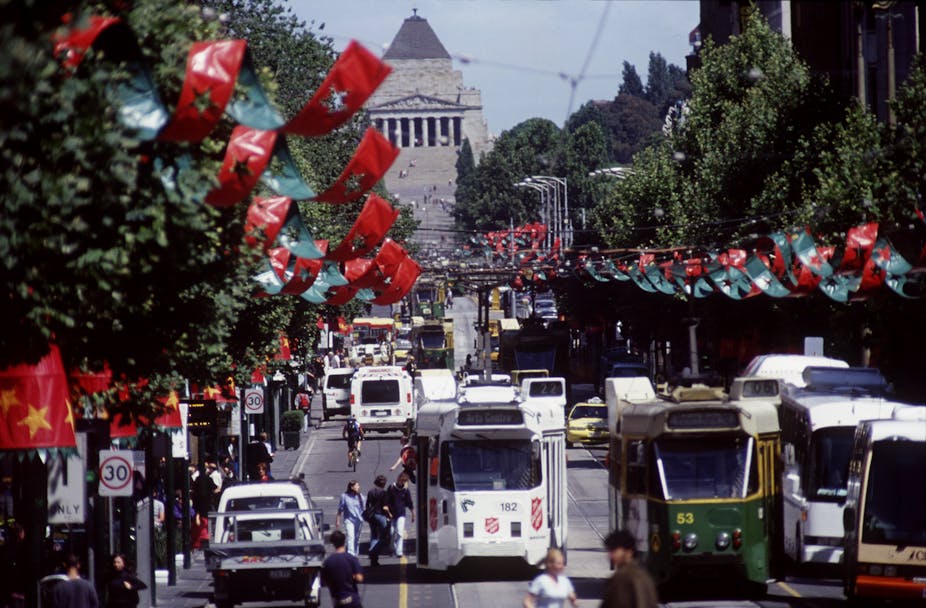Isolation and loneliness pose an increasing threat to the health of Australians, many of whom are cut off from friends and locals by ill-conceived urban design, a report has warned.
Social Cities, produced by public policy think tank the Grattan Institute, says that although social networks are better in Australia than many countries, friendships and neighbourhood connections have diminished over the past two decades, and the changing population means these trends could worsen.
Between 1984 and 2005, the percentage of Australians who said they did not have any trusted friends rose from 4% to 6%, while the percentage who felt they could not call on locals for help increased from 11% to 13%, according to research cited by the report. The figures are expected to worsen with the rise in the number of single-person households, which now make up a quarter of all homes.
“Without relationships we wither – individually and collectively,” says the report, released today. “It’s now recognised that loneliness is up there with high blood pressure, lack of exercise, obesity, and smoking as an indicator of shortened life expectancy.”
One factor in the atomisation of local communities is the long, stressful distances many people commute to work. The mean weekly commuting time for full-time workers in capital cities rose from 4.8 hours to 5.2 hours between 2002 and 2006.
“Most commuting in Australia is done by driving, and some researchers have suggested that car commuting is particularly harmful to social connection,” the report says. “Driving to work is usually done alone and typically features unpredictable stops and starts, being stuck in traffic and competing with other drivers, who are often perceived as rude. This helps explain why over 80% of Australian drivers find their commute stressful and frustrating.”
Limited mobility is another problem in Australian cities, where “not having a car is a huge barrier” to travel. “Many people who cannot afford a car, or cannot drive, are not well served by public transport.”
In Melbourne, almost 8% of areas with the greatest need for public transport have no access at all. This compares with less than 2% of areas with lower than average transport needs.
Public spaces such as parks and squares, and places for social activities such as community centres, sports grounds, cafes and shops, are a crucial ingredient in strong social networks, said the author of the report, the Grattan Institute’s Program Director of Cities, Jane-Frances Kelly.

Ms Kelly listed Melbourne’s CBD and Brisbane’s South Bank Parklands as two outstanding examples of urban design. “The CBD of Melbourne is a lively place, a pleasant place to be and to meet other people and interact.” Swanston Street is a “much more pleasant place to be” than George Street in Sydney, where narrow footpaths and heavy traffic noise make for a sometimes uncomfortable experience, she said.
In her report, Ms Kelly proposes that cities boost social connection by building more pop-up parks in unused or derelict spaces, increasing games and activities in parks, promoting public art and active street-fronts, slowing traffic in residential streets, and opening up schools to after-hours use, among other ideas.
“As social networks fragment, our basic psychological needs are not met, putting us at risk of suffering from loneliness – a condition that is linked to poor health and wellbeing,” she said.
One-person households are the fastest-growing household type, expected to grow from 24% of all households in 2006 to 28% in 2030, figures cited by the report show.
“The social trends that explain this are complex,” Ms Kelly said. “The way we build and organise our cities isn’t going to resolve them all, but we need to recognise that the social life of an ever-increasing number of people has to happen outside the home, which makes those external arrangements - the way cities are built and organised - more and more important.”
Billie Giles-Corti, a Professor of Health Promotion and Director of the McCaughey VicHealth Centre at the University of Melbourne, said there “are two major issues here. The first is urban sprawl, which means that when people are having to drive long distances and are spending a lot of time outside their community, then they’re not engaging with people locally. That’s weakening social networks.
"The other side is increased density, which also has the potential to affect social connections, because unless high-density housing has opportunities for people to interact where it feels comfortable, that’s also going to decrease our connections.”
Professor Giles-Corti said that as Australian cities continue to grow, it is crucial that planners increase public spaces: “The evidence shows that public open space is restorative, it reduces stress and mental fatigue. It’s a buffer against a busy world. It also allows us to interact and build connections with other people.”

